The Sustainable Development of Choronymic Cultural Landscapes in China Based on Geo-Informatic Tupu
Abstract
1. Introduction
2. Data and Methods
2.1. Data Sources and Preparation
2.2. Research Methods
2.2.1. Spatial-Temporal Database of Choronym Evolution
2.2.2. The Kernel Density Estimation Method
2.2.3. Spatial-Temporal Variation Indicators
2.2.4. The Spatial Association Indicator
2.2.5. Geo-Informatic Tupu
3. Results
3.1. Spatial–Temporal Pattern Evolution of Choronymic Cultural Landscape Entities
3.2. Spatial–Temporal Variation of Choronymic Cultural Landscape Entities
3.2.1. Spatial Variation of Choronym Entities
3.2.2. Temporal Variation of Choronym Entities
3.3. Spatial Association of Choronymic Cultural Landscape Entities
3.4. Semantic Evolution of Choronymic Cultural Landscapes Entities
3.4.1. Toponymic Words’ Cultural Characteristics
3.4.2. Millennium Ancient Counties (An Important Part of Toponymic Cultural Heritages)
4. Discussion
4.1. Influencing Factors of Spatial–Temporal Distribution of Choronymic Cultural Landscapes
4.2. Differences and Stability of Choronymic Cultural Landscapes Spatial Agglomeration Between the Two Sides of the “Hu Line”
4.3. Proposals for the Sustainable Development of Choronymic Cultural Landscapes and the Protection of Toponymic Cultural Heritages
5. Conclusions
- (1)
- The number of choronyms and spatial distribution of toponym density were all different since the Qin dynasty. The regions with high toponym density were generally located in plain areas. The cores of toponym density gradually spread from the middle–lower reaches of the Yellow River to the Yangtze Plain, the Chengdu Plain, and the Pearl River Delta Plain.
- (2)
- The spatial distribution of choronyms was agglomerative since the Qin dynasty. The Tang dynasty had the highest unevenness, while the period of the ROC had the lowest unevenness. The spatial distribution especially was uneven at the national scale and provincial scale since the Yuan dynasty. The choronyms were unevenly distributed among province-level administrative regionalizations since the Yuan dynasty. Relatively, the Yuan dynasty was the most concentrated, and the PRC was the least. Moreover, the temporal distribution of choronyms at high, prefecture, and county levels was centralized. The high level was the most concentrated, followed by the prefecture level and county level.
- (3)
- The spatial agglomeration phenomena of choronyms were positively clustered over the regions in the Qin, Western Jin, Northern and Southern Dynasties, Tang, Northern Song, Southern Song, Yuan, Ming, and Qing. By contrast, the spatial agglomerations of the choronyms were negatively clustered over the regions in the periods of the Western Han, Eastern Han, Sui, ROC, and PRC. Furthermore, the Ming presents the highest degree of spatial aggregation, followed by the Northern Song and Yuan dynasties, while the aggregation extents of the Qin, Sui, Tang, and Qing dynasties were comparatively low.
- (4)
- Among the top 20 words of choronyms since the Qin, the “Yang”, “Cheng”, “Shan”, “An”, “Ping”, “Ning”, “Jiang”, and “Nan” had high frequencies, and the words relevant to blessings, orientation and hydrological features had high proportions in the top 20 words.
- (5)
- There were 826 county-level choronyms with a naming time from over 1000 years ago in China, and there were approximately 60 counties still using the names of the Qin and Han dynasties until 2002. However, only 81 county-level choronyms were identified as “Millennium Ancient Counties” by the Ministry of Civil Affairs by the end of 2017, and the spatial distribution of the county-level choronyms named over the last 1000 years and “Millennium Ancient Counties” were all unbalanced at the national scale and provincial scale.
Author Contributions
Funding
Acknowledgments
Conflicts of Interest
References
- Sauer, C.O. Recent Development in Cultural Geography. In Recent Development in the Social Science; Hayes, E.C., Ed.; Lippincott: New York, NY, USA, 1927. [Google Scholar]
- Cosgrove, D.; Jackson, P. New directions in cultural geography. Area 1987, 19, 95–101. [Google Scholar]
- China Encyclopedia Editor Committee “Geography” Editorial Board. The Encyclopedia of China: Geography, Article Name; The Encyclopedia of China Press: Beijing, China, 1992. (In Chinese) [Google Scholar]
- Wang, H.B.; Yang, R.R. Spatial distribution characteristics of toponymic landscape in Baoding. J. Arid Land Resour. Environ. 2018, 32, 99–105. (In Chinese) [Google Scholar]
- Zhu, P.F. Research on Cultural Sights Named after Geographical Name in Changbai Mountains. Master’s Thesis, Yanbian University, Yanji, China, 2008. (In Chinese). [Google Scholar]
- Conedera, M.; Vassere, S.; Neff, C.; Meurer, M.; Krebs, P. Using toponymy to reconstruct past land use: A case study of ‘brüsáda’ (burn) in southern Switzerland. J. Hist. Geogr. 2007, 33, 729–748. [Google Scholar] [CrossRef]
- Hu, H.N.; Zhang, L.R. Cultural landscapes of place names of administrative regions in Shaanxi province. Areal Res. Dev. 2013, 32, 170–174. (In Chinese) [Google Scholar]
- Liu, B.Q.; Li, B.Y.; Song, J.C.; Zhang, Q.H. An Introduction of Toponymic Cultural Heritages; China Society Press: Beijing, China, 2011. (In Chinese) [Google Scholar]
- Moseley, C. (Ed.) Atlas of the World’s Languages in Danger, 3rd ed.; UNESCO Publishing: Paris, France, 2010. [Google Scholar]
- Situ, S.J. Historical geography study of toponyms of Guangdong province. Collect. Essays Chin. Hist. Geogr. 1992, 1, 21–55. (In Chinese) [Google Scholar]
- Wang, J.T. Introduction of Toponymy; China Social Sciences Publishing: Beijing, China, 1993. (In Chinese) [Google Scholar]
- Hua, L.F. Textual Research on the History of Toponymy in China; Social Sciences Literature Press: Beijing, China, 2002. (In Chinese) [Google Scholar]
- Chu, Y.P. Essays on Toponymy; Higher Education Press: Beijing, China, 1986. (In Chinese) [Google Scholar]
- Ma, Y.L. New Exploration of Toponymy; Nanjing University Press: Nanjing, China, 1993. (In Chinese) [Google Scholar]
- Sun, D.H. History of Geographical Names in China; China’s Environment Press: Beijing, China, 1997. (In Chinese) [Google Scholar]
- Niu, R.C. Dictionary of the Origin of Chinese Geographical Names; Minzu University of China Press: Beijing, China, 1999. (In Chinese) [Google Scholar]
- Song, J.C. Study of Place Names Culture: Concepts, Ethnic Languages, Place Names and Others; Law Press: Beijing, China, 2010. (In Chinese) [Google Scholar]
- Tang, G.P. Linguistics in Place Names of Panzhihua; Southwest Jiaotong University Press: Chengdu, China, 2012. (In Chinese) [Google Scholar]
- Sweeney, S.; Jurek, M.; Bednar, M. Using place names to interpret former floodplain connectivity in the Morava River, Czech Republic. Landsc. Ecol. 2007, 22, 1007–1018. [Google Scholar] [CrossRef]
- Sandu, I.; Poruciuc, A.; Alexianu, M. Salt and human health: Science, archaeology, ancient texts and traditional practices of eastern Romania. Mank. Q. 2010, 50, 225–256. [Google Scholar]
- Hu, Y. Spatio–Temporal Relationships among Chinese Ancient and Modern Placenames Oriented to Genealogy GIS. Master’s Thesis, Nanjing Normal University, Nanjing, China, 2008. (In Chinese). [Google Scholar]
- Sousa, A.; García-Murillo, P.; Sahin, S.; Morales, J.; García–Barrón, L. Wetland place names as indicators of manifestations of recent climate change in SW Spain (Doñana Natural Park). Clim. Chang. 2010, 100, 525–557. [Google Scholar] [CrossRef]
- Wang, C.S.; Ma, Q.L. Temporal-spatial distribution of villages in Beijing based on toponym change. J. Arid Land Resour. Environ. 2015, 29, 18–23. (In Chinese) [Google Scholar]
- Luo, W.; Hartmann, J.F.; Wang, F.H. Terrain characteristics and Tai toponyms: A GIS analysis of Muang, Chiang and Viang. GeoJournal 2010, 75, 93–104. [Google Scholar] [CrossRef]
- Wang, F.H.; Wang, G.X.; Hartmann, J.; Luo, W. Sinification of Zhuang place names in Guangxi, China: A GIS–based spatial analysis approach. Trans. Inst. Br. Geogr. 2012, 37, 317–333. [Google Scholar] [CrossRef]
- Wang, F.H.; Wang, G.X.; Li, X.J. GIS–based spatial analysis of Zhuang place names in Guangxi, China. Geogr. Res. 2013, 32, 487–496. (In Chinese) [Google Scholar]
- Wang, B.; Situ, S.J. Analysis of spatial characteristics of place names landscape based on GIS technology in Guangdong Province. Geogr. Res. 2007, 26, 238–248. (In Chinese) [Google Scholar]
- Chen, C.; Xiu, C.L.; Chen, W. Spatial distribution characteristics of place–name landscape based on GIS approach in Beijing and its reasons for the formations. Sci. Geogr. Sin. 2014, 34, 420–429. (In Chinese) [Google Scholar]
- Sun, B.S.; Guo, C.E.; Yang, Y.T.; Ge, W. Spatial distribution characteristics of rural place–name cultural landscape based on GIS approach in Chengde. Sci. Geogr. Sin. 2017, 37, 244–251. (In Chinese) [Google Scholar]
- Tucci, M.; Ronza, R.W.; Giordano, A. Fragments from many pasts: Layering the toponymic tapestry of Milan. J. Hist. Geogr. 2011, 37, 370–384. [Google Scholar] [CrossRef]
- Calvo-Iglesias, M.S.; DÍaz-Varela, R.A.; MÉndez-MartÍnez, G.; Fra-Paleo, U. Using place names for mapping the distribution of vanishing historical landscape features: The Agras Field System in Northwest Spain. Landsc. Res. 2012, 37, 501–517. [Google Scholar] [CrossRef]
- Fuchs, S. History and heritage of two midwestern towns: A toponymic-material approach. J. Hist. Geogr. 2015, 48, 11–25. [Google Scholar] [CrossRef]
- Qian, S.W.; Kang, M.J.; Weng, M. Toponym mapping: A case for distributionof ethnic groups and landscape features in Guangdong, China. J. Maps 2016, 12, 546–550. [Google Scholar] [CrossRef]
- Zhu, Z.H.; Zhang, H.Y.; Zhao, J.J.; Guo, X.Y.; Zhang, Z.X.; Ding, Y.L.; Xiong, T. Using Toponyms to Analyze the Endangered Manchu Language in Northeast China. Sustainability 2018, 10, 563. [Google Scholar]
- Liu, J.D.; Jin, R.C.; Zhou, K.Y. Political Geography of China; Science Press: Beijing, China, 1999. (In Chinese) [Google Scholar]
- Hua, L.F. Research on the History of Chinese Toponyms; Qilu Publishing House: Jinan, China, 2006. (In Chinese) [Google Scholar]
- Tan, Q.X. The Historical Atlas of China; China Cartographic Publishing House: Beijing, China, 1982. (In Chinese) [Google Scholar]
- Shi, W.L. Dictionary of Chinese Historical Toponyms; China Social Sciences Press: Beijing, China, 2005. (In Chinese) [Google Scholar]
- Niu, R.C. The New Century Chinese City View; People’s Daily Publishing Corporation of China: Beijing, China, 2002. (In Chinese) [Google Scholar]
- Zhou, Z.H. The Changes of Administrative Divisions in Chinese History; China’s International Broadcasting Publishing House: Beijing, China, 1998. (In Chinese) [Google Scholar]
- Dai, J.L. Encyclopedic Dictionary of Ancient and Modern Chinese Geographical Names; Shanghai Lexicographical Publishing House: Shanghai, China, 2005. (In Chinese) [Google Scholar]
- Niu, R.C. China’s Toponyms Anecdotes Dictionary; China Social Sciences Press: Beijing, China, 2016. (In Chinese) [Google Scholar]
- Wang, Y.J.; Yuan, K.S.; Yu, Z.Y. Multi–Dimensional Dynamic Geoscience Information Visualization; The Science Press: Beijing, China, 2003. (In Chinese) [Google Scholar]
- Liu, R.; Hu, W.P.; Wang, H.L.; Wu, C.; He, J. The road network evolution of Guangzhou–Foshan metropolitan area based on Kernel Density Estimation. Sci. Geogr. Sin. 2011, 31, 81–86. (In Chinese) [Google Scholar]
- Yu, W.H.; Ai, T.H.; Yang, M.; Liu, J.P. Detecting “Hot Spots” of facility POIs based on kernel density estimation and spatial autocorrelation technique. Geomat. Inf. Sci. Wuhan Univ. 2016, 41, 221–226. (In Chinese) [Google Scholar]
- Stephen, L.J. Tourism Analysis: A Handbook; Longman Group: London, UK, 1989. [Google Scholar]
- Lovie, P. Coefficient of variation. Encycl. Stat. Behav. Sci. 2005, 1, 317–318. [Google Scholar]
- Bao, J.G.; Zheng, H.Y.; Dai, G.Q. The evolvement of spatial structure and the significance of Guilin’s domestic tourist origins. Acta Geogr. Sin. 2002, 57, 96–106. (In Chinese) [Google Scholar]
- Wu, B.H.; Tang, Z.Y. A study on spatial structure of national 4A grade tourism attractions in China. Hum. Geogr. 2003, 18, 1–5. (In Chinese) [Google Scholar]
- Zhou, Y.X. Urban Geography; The Commercial Press: Beijing, China, 1995; p. 295. (In Chinese) [Google Scholar]
- Moran, P.A. The interpretation of statistical maps. J. R. Stat. Soc. Ser. B Methodol. 1948, 10, 243–251. [Google Scholar] [CrossRef]
- Chen, S.P.; Yue, T.X.; Li, H.G. Studies on Geo-Informatic Tupu and its application. Geogr. Res. 2000, 19, 337–343. (In Chinese) [Google Scholar]
- Liao, K. The discussion and prospect for Geo-Informatic Tupu. Geo-Inf. Sci. 2002, 1, 14–20. (In Chinese) [Google Scholar]
- Qi, Q.W. The latest development on Geo-Informatic Tupu. Sci. Surv. Mapp. 2004, 29, 15–23. (In Chinese) [Google Scholar]
- Ye, Q.H.; Tian, G.L.; Liu, G.H.; Ye, J.M.; Yao, X.; Liu, Q.S.; Lou, W.G.; Wu, S.G. Tupu methods of spatial—Temporal pattern on land use changes: A case study in the Yellow River Delta. J. Geogr. Sci. 2004, 14, 131–142. (In Chinese) [Google Scholar]
- Zhang, R.Q. The research progress of Geo-Informatic Tupu. Sci. Surv. Mapp. 2009, 34, 14–16. (In Chinese) [Google Scholar]
- Zheng, H.R.; Luo, H.X.; Zou, Y.Q.; Cheng, Y.S.; Zhang, R. Quantifying vegetation restoration in a karst rocky desertification area in Chongqing based on Geoinformatic Tupu. Acta Ecol. Sin. 2016, 36, 6295–6307. (In Chinese) [Google Scholar]
- Liao, K. Modern Cartography; Science Press: Beijing, China, 2003. (In Chinese) [Google Scholar]
- Wang, Y.; Wang, Y.; Fang, L.; Zhang, S.; Zhang, T.; Li, D.; Ge, D. Spatial-temporal characteristics and causes of changes to the county-level administrative toponyms cultural landscape in the eastern plains of China. PLoS ONE 2019, 14, e0217381. [Google Scholar] [CrossRef] [PubMed]
- Ye, Z.R.; Zheng, H.S. County system: The basis of China’s administrative system. Tian Fu New Idea 2012, 6, 93–99. (In Chinese) [Google Scholar]
- Hu, H.Y. Distribution of China’s population: Accompanying charts and density map. Acta Geogr. Sin. 1935, 2, 33–74. (In Chinese) [Google Scholar]
- Hu, H.Y. The distribution, regionalization and prospect of China’s population. Acta Geogr. Sin. 1990, 45, 139–145. (In Chinese) [Google Scholar] [PubMed]
- Qi, W.; Liu, S.H.; Zhao, M.F.; Liu, Z. China’s different spatial patterns of population growth based on the “Hu Line”. J. Geogr. Sci. 2016, 26, 1611–1625. [Google Scholar] [CrossRef]
- Shi, N.H. Study on toponyms and the exploration of relevant laws. Collect. Essays Chin. Hist. Geogr. 1985, 1, 36–41. (In Chinese) [Google Scholar]
- Zhuang, H.B.; Wang, B.X. A study on the etymology of “Jiang” in Northeast China. Mod. Chin. Stud. 2011, 13, 148–152. (In Chinese) [Google Scholar]
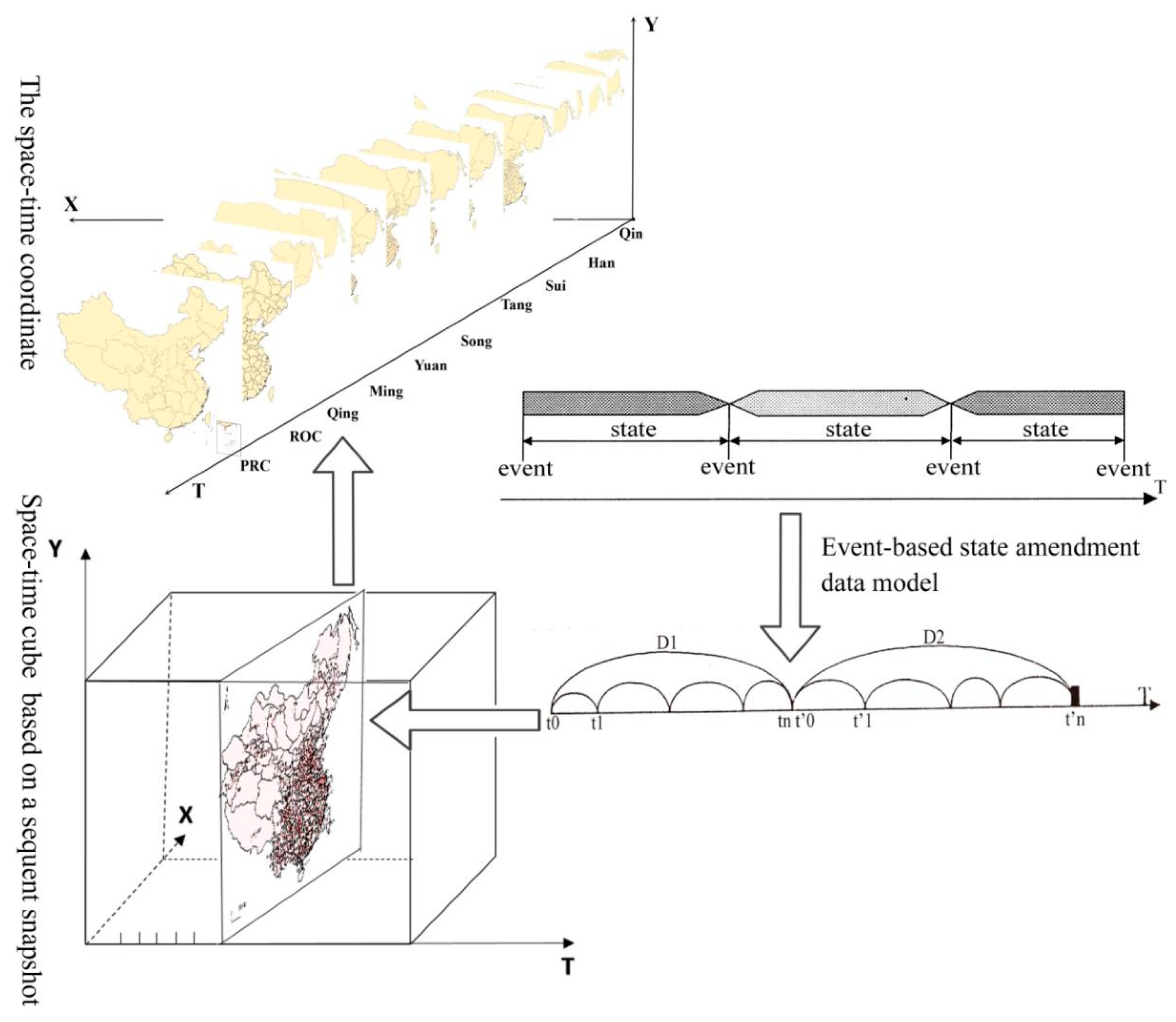


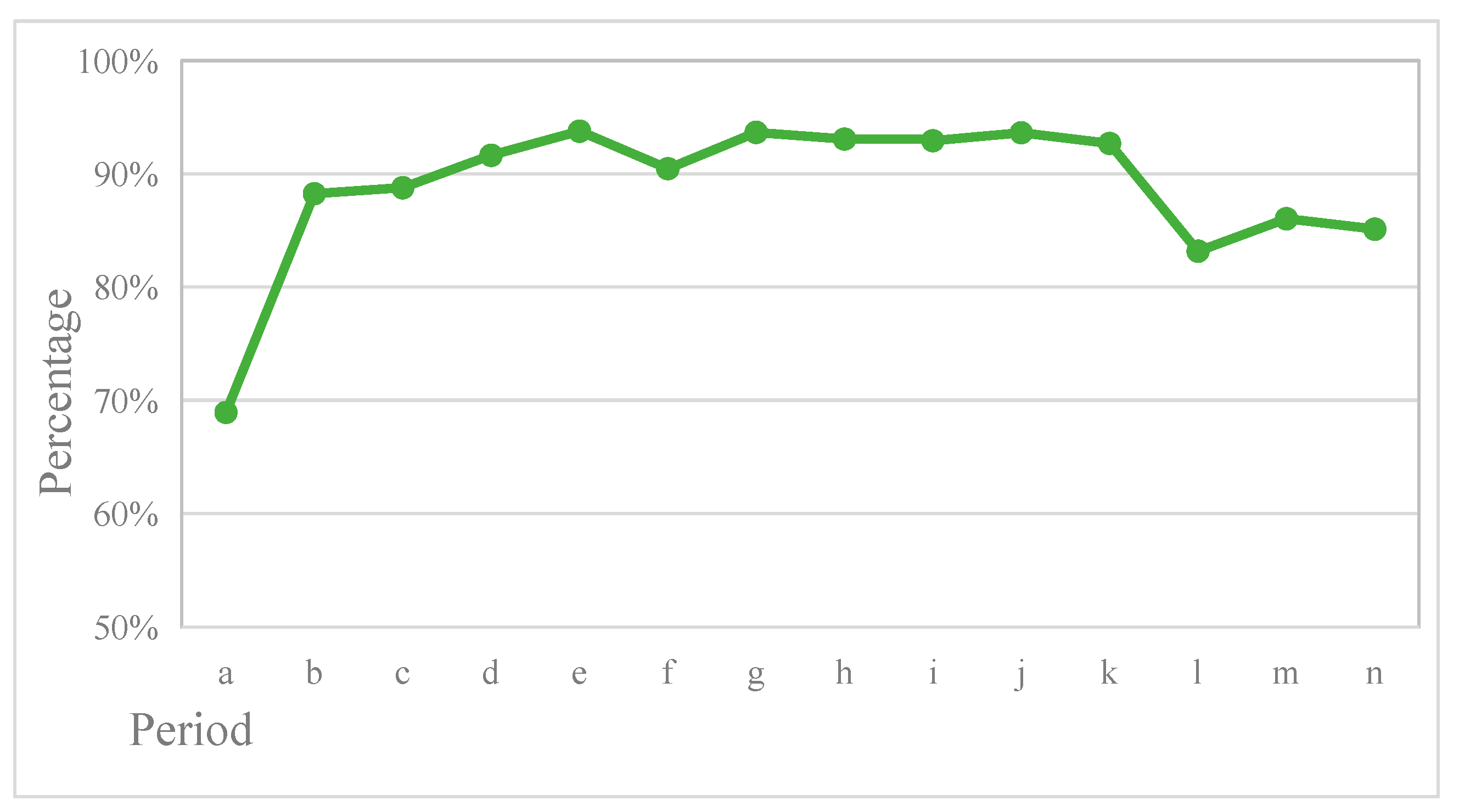


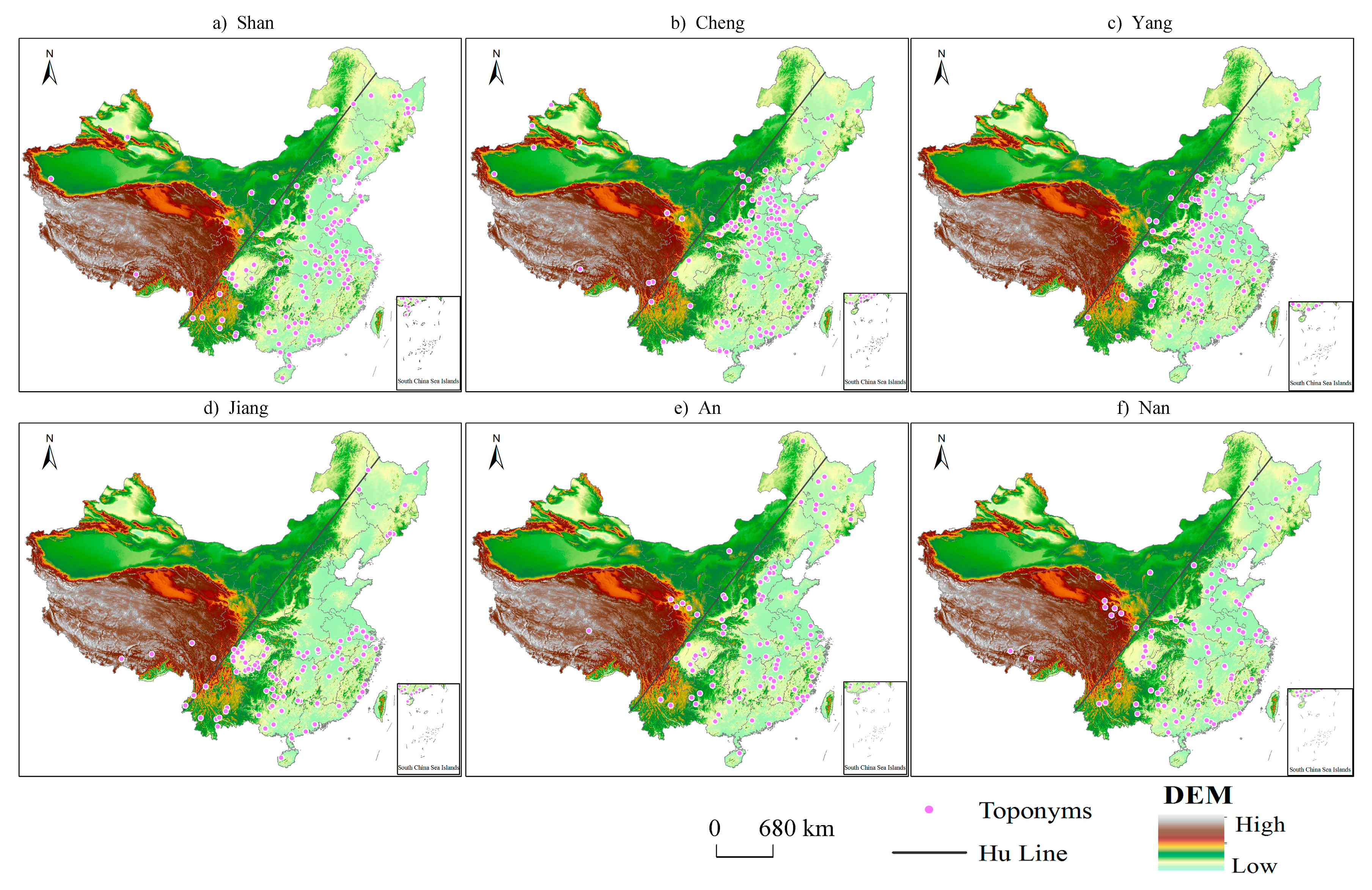
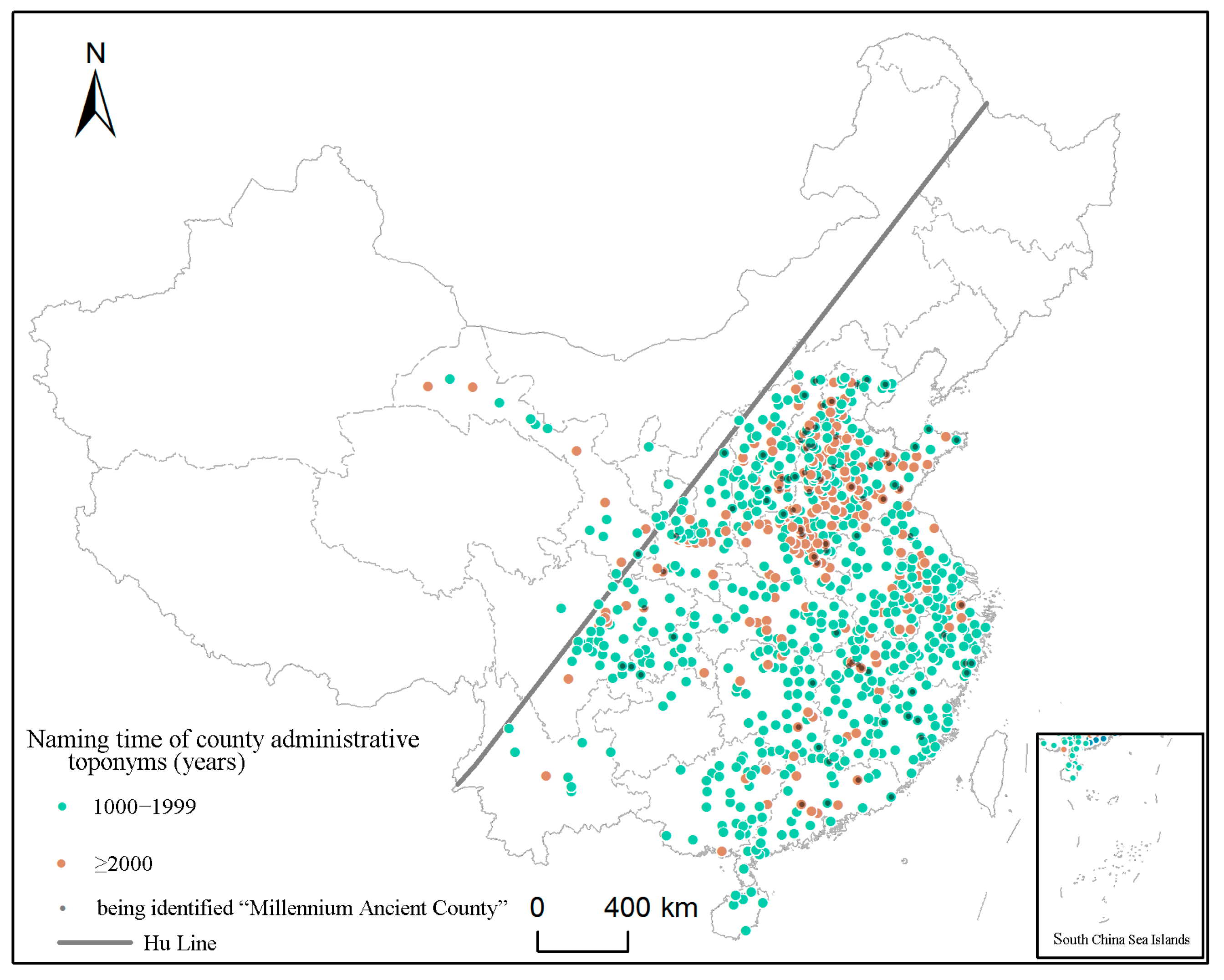
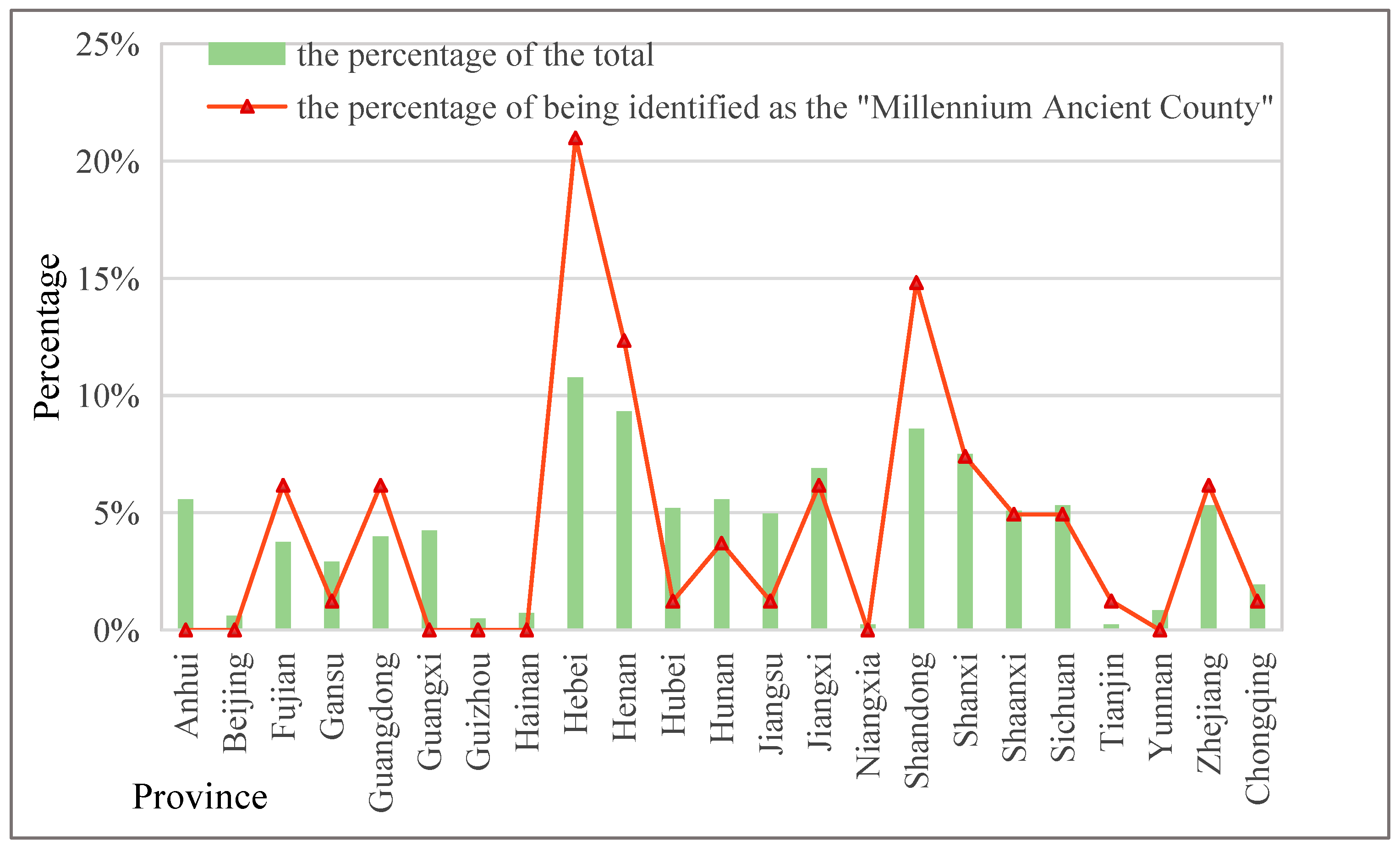
| Period | Year | Scale |
|---|---|---|
| Qin | The late Qin dynasty | 1:21,000,000 |
| Western Han | 7 BC | 1:21,000,000 |
| Eastern Han | 140 AD | 1:21,000,000 |
| Western Jin | 281 AD | 1:21,000,000 |
| Northern and Southern Dynasties | 497 AD | 1:21,000,000 |
| Sui | 612 AD | 1:21,000,000 |
| Tang | 741 AD | 1:21,000,000 |
| Northern Song | 1111 AD | 1:21,000,000 |
| Southern Song | 1208 AD | 1:21,000,000 |
| Yuan | 1330 AD | 1:21,000,000 |
| Ming | 1582 AD | 1:21,000,000 |
| Qing | 1820 AD | 1:21,000,000 |
| ROC | 1925 AD | 1:21,000,000 |
| PRC | 2010 AD | 1:1,000,000 |
| Type ID | 1 | 2 | 3 | 4 | 5 | 6 | 7 |
|---|---|---|---|---|---|---|---|
| Type Name | Name | Rename | Cancel | Position migration | Boundary change | Gradec hange | Membership change |
| Period | High-Level Choronyms | Prefecture-Level Choronyms | County-Level Choronyms | Total |
|---|---|---|---|---|
| Qin | 48 | 1000 | 1048 | |
| Western Han | 103 | 1587 | 1690 | |
| Eastern Han | 13 | 102 | 1180 | 1295 |
| Western Jin | 21 | 176 | 1232 | 1429 |
| Northern and Southern Dynasties | 253 | 403 | 1562 | 2218 |
| Sui | 194 | 1271 | 1465 | |
| Tang | 15 | 323 | 1575 | 1913 |
| Northern Song | 34 | 353 | 1288 | 1675 |
| Southern Song | 49 | 402 | 1386 | 1837 |
| Yuan | 13 | 287 | 1131 | 1431 |
| Ming | 18 | 398 | 1427 | 1843 |
| Qing | 23 | 302 | 1549 | 1874 |
| ROC | 31 | 82 | 2044 | 2157 |
| PRC | 34 | 334 | 2851 | 3219 |
| Period | G | Gini | S |
|---|---|---|---|
| Yuan | 35.50 | 0.98 | 0.39 |
| Ming | 25.26 | 0.97 | 0.31 |
| Qing | 21.75 | 0.96 | 0.25 |
| ROC | 20.69 | 0.94 | 0.21 |
| PRC | 20.42 | 0.92 | 0.20 |
| Name | ANN | Z | Name | ANN | Z |
|---|---|---|---|---|---|
| Anhui | 0.82 | −3.76 | Jiangxi | 1.01 | 0.16 |
| Beijing | 1.36 | 2.99 | Jilin | 0.86 | −2.21 |
| Chongqing | 1.07 | 0.83 | Liaoning | 0.80 | −4.11 |
| Fujian | 0.93 | −1.25 | Ningxia | 0.77 | −2.28 |
| Gansu | 0.69 | −5.88 | Qinghai | 0.84 | −2.25 |
| Guangdong | 0.76 | −5.63 | Shandong | 0.91 | −2.15 |
| Guangxi | 0.85 | −3.16 | Shanghai | 1.28 | 2.42 |
| Guizhou | 1.12 | 2.23 | Shanxi | 1.04 | 0.92 |
| Hainan | 1.65 | 5.86 | Shaanxi | 0.88 | −2.36 |
| Hebei | 0.86 | −3.60 | Sichuan | 0.88 | −3.35 |
| Heilongjiang | 0.75 | −5.59 | Tianjin | 1.15 | 1.24 |
| Henan | 0.88 | −3.16 | Tibet | 0.98 | −0.26 |
| Hubei | 0.90 | −2.05 | Xinjiang | 0.66 | −6.94 |
| Hunan | 0.97 | −0.70 | Yunnan | 0.89 | −2.42 |
| Inner Mongolia | 0.80 | −4.03 | Zhejiang | 0.91 | −1.85 |
| Jiangsu | 0.89 | −2.35 |
| Index | High-Level Choronyms | Prefecture-Level Choronyms | County-Level Choronyms |
|---|---|---|---|
| G | 41.16 | 29.84 | 27.89 |
| Gini | 0.98 | 0.95 | 0.81 |
| S | 0.57 | 0.30 | 0.16 |
| Rank | a | b | c | d | e | f | g | h | i | g | k | l | m | n |
|---|---|---|---|---|---|---|---|---|---|---|---|---|---|---|
| 1 | Yang | Yang | Yang | Yang | Yang | Yang | Cheng① | Yang | Yang | An | An | An | Yang | Shan |
| 2 | Ling | Ping | Ping | Ping | Cheng | Cheng | Yang | Cheng① | Cheng① | Ning | Ning | Ning | An | Cheng① |
| 3 | Dong | Ling | Ling | An | An | An | An | An | An | Yang | Yang | Yang | Cheng① | Yang |
| 4 | Cheng① | An | Cheng① | Cheng① | Ping | Ping | Shan | Shan | Shan | Ping | Ping | Yi② | Shan | Jiang |
| 5 | Ping | Cheng① | An | Ling | Nan | Shan | Ping | Ping | Ping | Nan | Shan | Cheng① | Jiang | An |
| 6 | Yi① | Wu | Wu | Nan | Xin | Chuan | Shui | Ning | Ning | Cheng① | Cheng① | Ping | Ning | Nan |
| 7 | Wu | Cheng② | Nan | Chang | Ning | Shui | Nan | Jiang | Jiang | Shan | Nan | Shan | Ping | Dong |
| 8 | Lin | Nan | Lin | Xin | Ling | Nan | Chuan | Nan | Shui | Jiang | Jiang | Jiang | Nan | Ping |
| 9 | Yin | Dong | Dong | Wu | Chang | Ling | Chang | Hua | Wu | De | Hai | Zuo | Er | Ning |
| 10 | An | Gao | Yin | Lin | Dong | Wu | Wu | Yong | Chang | He | You | He | He | |
| 11 | Zhong | Lin | Guang | Xi① | Wu | Chang | Jiang | Wu | Chuan | Xin | Er | Yi② | Xi① | |
| 12 | Shi | Du | Du | Dong | Jiang | Le | Shui | Chang | Xi② | Da | Zhong | Dong | Xin | |
| 13 | Nan | Yin | Cheng② | Guang | Guang | Lin | Ling | He | Hua | Yong | Yong | Nan | Xi① | Hai |
| 14 | Jiang | Chang | Gao | Du | Bei | Ning | Du | Lin | Yong | Long | Xi② | Yong | Chuan | Long |
| 15 | He | Guang | Qiu | Yin | Lin | Qing | Lin | Xi① | Lin | Xin | Chang | Xin | Xin | Chuan |
| 16 | Xin | Qiu | Shi | Gao | Le | He | Long | Chang | Qing | Hua | Ding | Chang | Wu | |
| 17 | Xiang① | Xiang② | Xi① | Xi① | Xiang② | Xin | Chuan | Nan | Ding | Wu | Ding | Yong | Er | |
| 18 | Shan | Xin | Chang | Ning | Gao | Le | Ning | Xin | Wu | Zhong | Hua | Shui | Shui | |
| 19 | Chen | Shan | Zhong | Le | Shan | Chang | Yi③ | De | Chang | Qing | Dong | Wu | Chang | Da |
| 20 | Du | Zhong | Xin | Shan | Shui | Yong | Yong | Chang | Xi② | Shui | Hai | Wu |
© 2019 by the authors. Licensee MDPI, Basel, Switzerland. This article is an open access article distributed under the terms and conditions of the Creative Commons Attribution (CC BY) license (http://creativecommons.org/licenses/by/4.0/).
Share and Cite
Wang, Y.; Ge, D.; Zhang, T.; Wang, Y. The Sustainable Development of Choronymic Cultural Landscapes in China Based on Geo-Informatic Tupu. Sustainability 2019, 11, 4302. https://doi.org/10.3390/su11164302
Wang Y, Ge D, Zhang T, Wang Y. The Sustainable Development of Choronymic Cultural Landscapes in China Based on Geo-Informatic Tupu. Sustainability. 2019; 11(16):4302. https://doi.org/10.3390/su11164302
Chicago/Turabian StyleWang, Yingying, Dazhuan Ge, Tongyan Zhang, and Yingjie Wang. 2019. "The Sustainable Development of Choronymic Cultural Landscapes in China Based on Geo-Informatic Tupu" Sustainability 11, no. 16: 4302. https://doi.org/10.3390/su11164302
APA StyleWang, Y., Ge, D., Zhang, T., & Wang, Y. (2019). The Sustainable Development of Choronymic Cultural Landscapes in China Based on Geo-Informatic Tupu. Sustainability, 11(16), 4302. https://doi.org/10.3390/su11164302






